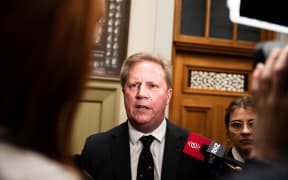
Between $3 and $23 billion needs to be paid by 2030 to buy carbon offsets from overseas to meet New Zealand's climate target. File photo. Photo: 123RF
Accounting is one of the biggest factors holding back climate action in New Zealand, according to accountant Wendy McGuinness.
The former Treasury contractor is trying to persuade Treasury to put the cost of meeting New Zealand's climate targets on the government's official financial statements.
The issue is the $3-$23 billion that needs to be paid by 2030, to buy carbon offsets from overseas to meet New Zealand's climate target.
Those billions will pay for an estimated 100 million tonnes of carbon dioxide reductions by other countries, which could cover projects such as retiring a coal-fired plant, installing a solar farm or planting a new forest.
The overseas top-up is planned because New Zealand's own carbon reductions are not on track to meet its whole first target under the Paris Agreement, and making purchases overseas is likely to be cheaper than doing all the work here.
But while there is bipartisan agreement that those billions of dollars need to be paid, they are currently invisible on the country's balance sheet - because they are not counted as a financial liability.
Bipartisan plan
Buying a large number of overseas offsets has been part of New Zealand's climate plan, ever since John Key's government first signed the Paris Agreement in 2016.
Official briefing notes from that period showed the cost of buying offshore credits to meet the 2030 target was expected to be higher then than it was now - up to $37 billion.
The most recent Labour-led government progressed work on designing bilateral deals with other countries to buy these credits, and that work is still ongoing.
There's no doubt in government circles that the payments will need to be made. National re-committed to the target before the election.
A recent briefing to Prime Minister Christopher Luxon for a meeting with Climate Change Minister Simon Watts (obtained by 350 Aotearoa campaigner Adam Currie) says: "New Zealand is not on track to meet [the first climate target] through domestic abatement alone and will require the purchasing of offshore offsets."
It said finding ways to make extra cuts inside the country should be explored, "but will be insufficient to deliver the full amount. Some degree of offshore purchasing is therefore essential to meet the commitment".
Although Treasury notes the existence of this obligation in the country's financial statements, it appears as a sidenote, not in the balance sheet. There is no financial provision for paying for it.
Accounting expert Wendy McGuinness is on a mission to persuade Treasury to re-think that call - and add a provision to this year's statements, due mid-2024.
A former Treasury contractor who now heads the McGuinness Institute thinktank, she has co-written a paper laying out why she thinks the cost meets accounting requirements for inclusion, a topic she has been discussing with Treasury.
"There's never been any Minister, to our knowledge, who has indicated that they would withdraw from the Paris Agreement. National signed the Paris Agreement," she says.
But she says: "They are really in effect hidden in the financial statements. And we need it in our faces because that's going to help us change."
McGuinness says what seems like a dry accounting argument actually affects local businesses, because the current setup favours overseas spending.
For example, say a New Zealand company wants the government to help it cut emissions by granting incentives for solar, or buying low-methane cattle feed, or some other action. The cost of that NZ spending by the government appears as a cost on the government's books.
But the savings produced from needing to buy fewer overseas carbon credits doesn't appear - because the offshore spending to meet the target was never counted as a financial liability in the first place.
"Imagine the leverage this would give New Zealand business. Because the counterfactual is we give all this money overseas, rather than transition our economy," McGuinness says.
Two ministers, same answer
During his tenure, former Climate Change Minister James Shaw asked Treasury to report on adding New Zealand's international climate targets to the financial accounts.
He believes it always should have been on there.
He says having it on the books would create more pressure for officials and ministers to find ways to cut emissions, in order to reduce the size of the bill to taxpayers from making payments overseas.
That could keep more of the spinoff jobs and benefits of climate spending inside New Zealand, he says.
Adding pressure and getting deals done sooner could also lock in lower prices for the offshore portion of the spending, ahead of an expected international rush on carbon credits closer to the end of the first Paris Agreement target period in 2030.
After the election, the current Climate Change Minister Simon Watts - working with Finance Minister Nicola Willis - asked Treasury again if the cost of meeting target should go in the official accounts.
He was also told no.
Treasury published its reasons in response to an OIA request.
It says the cost of meeting the climate target does not meet accounting standards, known as GAAP (generally accepted accounting practice) for being included as a liability. Among other things, GAAP requires that there's a reliably measurable obligation, which will probably result in a payment of money in future.
One reason Treasury says the payments don't meet this bar, is that it says the government could still avoid paying the money without suffering financial consequences, such as by putting the whole cost of meeting the target on the private sector. (Watts says this is theoretical, and not based on government policy).
Another reason is that Treasury says the cost can't be reliably estimated.
By international standards, buying up to a 100 million tonnes of carbon reductions is a big climate liability, relative to the size of New Zealand's economy, although several other counties are also on the hook to buy similar quantities of credits, or more. But the cost per tonne is still uncertain, depending who the seller is and the environmental standards the Government decides to apply.
Watts, himself a former accountant, says the size of the bill the country faces doesn't matter, if it doesn't meet the accounting bar for inclusion. And currently Treasury tells him it doesn't.
Watts says it was prudent to ask Treasury to reassess after the election, in case the situation had changed.
But he says other countries who will make similar international payments, also haven't put the liability in their financial statements. "We all face the same challenge," he says.
The case isn't necessarily closed, however, with Watts interested in watching international developments.
Accountant on a mission
McGuinness says recent developments have only strengthened the argument that the government can't avoid meeting the target, without suffering financial repercussions.
For example, meeting the climate target is in a binding section of New Zealand's newly-operational free trade deal with Europe.
Successive governments have committed to the target again and again, she says, and she believes the threshold has been crossed.
Treasury has already shifted a little, recently adding the cost of meeting the overseas portion of the Paris target as a note to its pre-election financial update.
The McGuinness Institute paper recommends it goes further, and add provision for buying credits to the government's 30 June 2024 financial statements.
There are different ways Treasury could do this, if it decided the bar was met.
McGuinness and climate policy analyst Christina Hood - who wrote a report to go with the paper - believes the liability should be dealt over a number of years to "stop the shock factor".
Hood says meeting the target is not a future problem that can be dealt with in 2031, contrary to what many people think.
She says the design of New Zealand's pledge means it has promised to reduce emissions to within a certain budget each year, over the entire decade to 2030 - not just reach a goal in the final year.
She says the government of the day can't just get to 2031 and fork out for carbon credits to cover the difference between New Zealand's emissions over the decade and the total allowed, or make up for excess emissions so far by making deeper cuts later. Treasury sees things differently.
As for how many tonnes of reductions the country would have to put on its books, if it followed this, she says that can be worked out fairly reliably.
The country's first progress report to the UN on its Paris target is due this December.
Hood calculates the gap between the annual budgets and real emissions so far - up to 30 June 2024 - is about 20 million tonnes.
The price is uncertain, but Treasury has published a range of estimates of how much New Zealand might pay per tonne in different scenarios.
At the cheaper end - assuming the government bought climate action from developing countries - it could be about $41 a tonne. Following the logic of Hood's analysis, that implies putting about $800 million of liability on the books, this year, to pay for the overshoot so far.
As for the chances of this happening - McGuinness says she realises it is a big ask, getting Treasury to do something that other countries haven't, yet.
But she says it would make the financial accounts a fairer reflection of reality, and lead to better decisions.
"It's better to have a rough figure, than have it hidden. Next year you can have a different assumption, and that informs the public - that's what it's all about."







